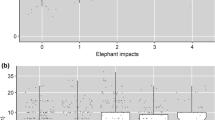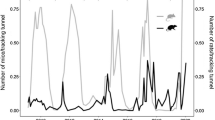Abstract
Previous studies on intraguild predation have mainly focused on within-class assemblages, even though avian top predators may also influence mammalian mesopredator prey. By using nation-wide long-term data from Finland, northern Europe, we examined the impacts of golden eagles (Aquila chrysaetos) together with red foxes (Vulpes vulpes) and pine martens (Martes martes) on forest-dwelling herbivores, black grouse (Tetrao tetrix) and hazel grouse (Tetrastes bonasia). We hypothesized that eagles may alleviate the overall predation pressure on grouse by imposing intraguild predation risk on mesopredators. The predation impact of eagle was modelled using eagle density estimates and distance to eagle nest. Wildlife triangle counts were used as predation impact proxies of mammalian mesopredators and as measures of response in grouse. Our results show that eagle density correlated negatively with black grouse abundance indices while being positively associated with the proportion of juveniles in both grouse species, irrespective of the abundance of mesopredators. Yet, foxes and martens alone had a negative effect on the abundance indices and the proportion of young in the two grouse species. This suggests that the possible cascading effects of eagles are not mediated by decreased mesopredator numbers, but instead by fear effects. Alternatively, they may be mediated by other species than fox or marten studied here. In conclusion, we found support for the hypothesis that eagles provide protection for juvenile black and hazel grouse, whereas they are a threat for adult grouse. This important information helps us to better understand the role of avian top predators in terrestrial ecosystems.




Similar content being viewed by others
References
Åberg J, Swenson JE, Angelstam P (2003) The habitat requirements of hazel grouse (Bonasa bonasia) in managed boreal forest and applicability of forest stand descriptions as a tool to identify suitable patches. Forest Ecol Manag 175:437–444. doi:10.1016/S0378-1127(02)00144-5
Angelstam P (2004) Habitat thresholds and effects of forest landscape change on the distribution and abundance of black grouse and capercaillie. Ecol Bull 51:173–187
Baddeley A, Turner R (2005) spatstat: an R package for analyzing spatial point patterns. J Stat Softw 12:1–42
Banks PB, Nordström M, Ahola M et al (2008) Impacts of alien mink predation on island vertebrate communities of the Baltic Sea archipelago: review of a long-term experimental study. Boreal Environ Res 13:3–16
Bêty J, Gauthier G, Giroux J-F, Korpimäki E (2001) Are goose nesting success and lemming cycles linked? Interplay between nest density and predators. Oikos 93:388–400
Bjornstad ON (2015) ncf: spatial nonparametric covariance functions. R package version 1.1-6. https://CRAN.R-project.org/package=ncf
Brainerd SM, Rolstad J (2002) Habitat selection by Eurasian pine martens Martes martes in managed forests of southern boreal Scandinavia. Wildlife Biol 8:289–297
Core Team R (2015) R: a language and environment for statistical computing. Version 3(2):3
Crooks KR, Soulé ME (1999) Mesopredator release and avifaunal extinctions in a fragmented system. Nature 400:563–566. doi:10.1038/23028
Dell’Arte GL, Laaksonen T, Norrdahl K, Korpimäki E (2007) Variation in the diet composition of a generalist predator, the red fox, in relation to season and density of main prey. Acta Oecol 31:276–281. doi:10.1016/j.actao.2006.12.007
Elmhagen B, Ludwig G, Rushton SP et al (2010) Top predators, mesopredators and their prey: interference ecosystems along bioclimatic productivity gradients. J Anim Ecol 79:785–794. doi:10.1111/j.1365-2656.2010.01678.x
Estes JA, Terborgh J, Brashares JS et al (2011) Trophic downgrading of planet Earth. Science 333:301–306. doi:10.1126/science.1205106
European Environment Agency (2009) CORILIS—CORINE Lissage (2000). European Union Open Data Portal. Permalink: 63eabc5a1a61b356b891c48638c519f3
Fey K, Banks PB, Oksanen L, Korpimäki E (2009) Does removal of an alien predator from small islands in the Baltic Sea induce a trophic cascade? Ecography 32:546–552. doi:10.1111/j.1600-0587.2008.05637.x
Finnish Meteorological Institute (2014) Open data: Finnish Climate Data set 1961–2000
Hakkarainen H, Korpimäki E (1996) Competitive and predatory interactions among raptors: an observational and experimental study. Ecology 77:1134–1142
Hanski I, Henttonen H, Korpimäki E et al (2001) Small-rodent dynamics and predation. Ecology 82:1505–1520
Kauhala K, Laukkanen P, von Rége I (1998) Summer food composition and food niche overlap of the raccoon dog, red fox and badger in Finland. Ecography 21:457–463. doi:10.1111/j.1600-0587.1998.tb00436.x
Kauhala K, Helle P, Helle E (2000) Predator control and the density and reproductive success of grouse populations in Finland. Ecography 23:161–168. doi:10.1034/j.1600-0587.2000.230201.x
Korpimäki E, Norrdahl K (1989) Avian predation on mustelids in Europe 1: occurrence and effects on body size variation and life traits. Oikos 55:205–215. doi:10.2307/3565424
Korpimäki E, Norrdahl K, Huitu O, Klemola T (2005) Predator-induced synchrony in population oscillations of coexisting small mammal species. Proc R Soc B Biol Sci 272:193–202. doi:10.1098/rspb.2004.2860
Kurki S, Helle P, Lindén H, Nikula A (1997) Breeding success of black grouse and capercaillie in relation to mammalian predator densities on two spatial scales. Oikos 79:301–310. doi:10.2307/3546014
Kurki S, Nikula A, Helle P, Lindén H (1998) Abundances of red fox and pine marten in relation to the composition of boreal forest landscapes. J Anim Ecol 67:874–886. doi:10.1046/j.1365-2656.1998.6760874.x
Lindén H, Helle E, Helle P, Wikman M (1996) Wildlife triangle scheme in Finland: methods and aims for monitoring wildlife populations. Finn Game Res 49:4–11
Lindström ER, Andrén H, Angelstam P et al (1994) Disease reveals the predator: sarcoptic mange, red fox predation, and prey populations. Ecology 75:1042–1049
Lindström ER, Brainerd SM, Helldin JO, Overskaug K (1995) Pine marten-red fox interactions: a case of intraguild predation? Ann Zool Fenn 32:123–130
Lourenço R, Penteriani V, Rabaça JE, Korpimäki E (2014) Lethal interactions among vertebrate top predators: a review of concepts, assumptions and terminology. Biol Rev 89:270–283. doi:10.1111/brv.12054
Lourenҫo R, Santos SM, Rabaҫa JE, Penteriani V (2011) Superpredation patterns in four large European raptors. Popul Ecol 53:175–185. doi:10.1007/s10144-010-0199-4
Ludwig GX, Alatalo RV, Helle P et al (2006) Short- and long-term population dynamical consequences of asymmetric climate change in black grouse. Proc R Soc B 273:2009–2016. doi:10.1098/rspb.2006.3538
Ludwig GX, Alatalo RV, Helle P, Siitari H (2010) Individual and environmental determinants of daily black grouse nest survival rates at variable predator densities. Ann Zool Fenn 47:387–397
Lyly MS, Villers A, Koivisto E et al (2015) Avian top predator and the landscape of fear: responses of mammalian mesopredators to risk imposed by the golden eagle. Ecol Evol 5:503–514. doi:10.1002/ece3.1370
Marcström V, Kenward RE, Engren E (1988) The impact of predation on boreal tetraonids during vole cycles: an experimental study. J Anim Ecol 57:859–872. doi:10.2307/5097
Marjakangas A, Rintamäki H, Hissa R (1984) Thermal responses in the capercaillie Tetrao urogallus and the black grouse Lyrurus tetrix roosting in the snow. Physiol Zool 57:99–104
Mönkkönen M, Husby M, Tornberg R et al (2007) Predation as a landscape effect: the trading off by prey species between predation risks and protection benefits. J Anim Ecol 76:619–629. doi:10.1111/j.1365-2656.2007.01233.x
Montadert M, Leonard P (2003) Survival in an expanding hazel grouse Bonasa bonasia population in the southeastern French Alps. Wildlife Biol 9:357–364
Newsome TM, Ripple WJ (2015) A continental scale trophic cascade from wolves through coyotes to foxes. J Anim Ecol 84:49–59. doi:10.1111/1365-2656.12258
Ollila T (2015) Raportti maakotkan, muuttohaukan, tunturihaukan sekä Oulun ja Lapin läänien merikotkien pesinnöistä vuonna 2015. Luontopalvelut, Metsähallitus
Ollila T, Ilmonen J (2009) Metsähallituksen vastuulajien tila ja suojelutaso vuonna 2006. Maakotka—Aquila chrysaetos (L.). Tietolomake, lajit. Metsähallitus
Palomares F, Gaona P, Ferreras P, Delibes M (1995) Positive effects on game species of top predators by controlling smaller predator populations: an example with lynx, mongooses, and rabbits. Conserv Biol 9:295–305
Pekkola M, Alatalo R, Pöysä H, Siitari H (2014) Seasonal survival of young and adult black grouse females in boreal forests. Eur J Wildl Res 60:477–488. doi:10.1007/s10344-014-0809-0
Pellikka J, Rita H, Lindén H (2005) Monitoring wildlife richness—Finnish applications based on wildlife triangle censuses. Ann Zool Fenn 42:123–134
Polis GA, Myers CA, Holt RD (1989) The ecology and evolution of intraguild predation: potential competitors that eat each other. Annu Rev Ecol Syst 20:297–330. doi:10.1146/annurev.es.20.110189.001501
Prugh LR, Stoner CJ, Epps CW et al (2009) The rise of the mesopredator. Bioscience 59:779–791. doi:10.1525/bio.2009.59.9.9
Pulliainen E, Ollinmäki P (1996) A long-term study of the winter food niche of the pine marten Martes martes in northern boreal Finland. Acta Theriol 41:337–352
Quinn JL, Ueta M (2008) Protective nesting associations in birds. Ibis 150:146–167. doi:10.1111/j.1474-919X.2008.00823.x
Quinn JL, Prop J, Kokorev Y, Black JM (2003) Predator protection or similar habitat selection in red-breasted goose nesting associations: extremes along a continuum. Anim Behav 65:297–307. doi:10.1006/anbe.2003.2063
Ripple WJ, Beschta RL (2012) Trophic cascades in Yellowstone: the first 15 years after wolf reintroduction. Biol Conserv 145:205–213. doi:10.1016/j.biocon.2011.11.005
Ritchie EG, Elmhagen B, Glen AS et al (2012) Ecosystem restoration with teeth: what role for predators? Trends Ecol Evol 27:265–271. doi:10.1016/j.tree.2012.01.001
Roemer GW, Gompper ME, van Valkenburgh B (2009) The ecological role of the mammalian mesocarnivore. Bioscience 59:165–173. doi:10.1525/bio.2009.59.2.9
Salo P, Nordström M, Thomson RL, Korpimäki E (2008) Risk induced by a native top predator reduces alien mink movements. J Anim Ecol 77:1092–1098. doi:10.1111/j.1365-2656.2008.01430.x
Saniga M (2002) Nest loss and chick mortality in capercaillie (Tetrao urogallus) and hazel grouse (Bonasa bonasia) in West Carpathians. Folia Zool 51:205–214
Sergio F, Hiraldo F (2008) Intraguild predation in raptor assemblages: a review. Ibis 150:132–145. doi:10.1111/j.1474-919X.2008.00786.x
Sih A, Englund G, Wooster D (1998) Emergent impacts of multiple predators on prey. Trends Ecol Evol 13:350–355
Storch I, Lindström E, de Jounge J (1990) Diet and habitat selection of the pine marten in relation to competition with the red fox. Acta Theriol 35:311–320
Sulkava S, Huhtala K, Rajala P, Tornberg R (1999) Changes in the diet of the Golden Eagle Aquila chrysaetos and small game populations in Finland in 1957–96. Ornis Fenn 76:1–16
Swenson JE, Angelstam P (1993) Habitat separation by sympatric forest grouse in Fennoscandia in relation to boreal forest succession. Can J Zool 71:1303–1310. doi:10.1139/z93-180
Swenson JE, Saari L, Bonczar Z (1994) Effects of weather on hazel grouse reproduction: an allometric perspective. J Avian Biol 25:8–14
Terborgh J, Estes JA (2010) Trophic cascades: predators, prey and the changing dynamics of nature. Island Press, Washington DC
Tornberg R (2001) Pattern of goshawk Accipiter gentilis predation on four forest grouse species in northern Finland. Wildlife Biol 7:245–256
Tornberg R, Helle P, Korpimäki E (2011) Vulnerability of black grouse hens to goshawk predation: result of food supply or predation facilitation? Oecologia 166:577–584. doi:10.1007/s00442-010-1884-x
Valkama J, Korpimäki E, Arroyo B et al (2005) Birds of prey as limiting factors of gamebird populations in Europe: a review. Biol Rev 80:171–203. doi:10.1017/s146479310400658x
Vance-Chalcraft HD, Rosenheim JA, Vonesh JR et al (2007) The influence of intraguild predation on prey suppression and prey release: a meta-analysis. Ecology 88:2689–2696. doi:10.1890/06-1869.1
Watson J (2010) The Golden Eagle, 2nd edn. Yale University Press, New Haven
Wood S (2011) Fast stable restricted maximum likelihood and marginal likelihood estimation of semiparametric generalized linear models. J R Stat Soc 73:3–36
Acknowledgments
We thank all the volunteers who have helped to collect the golden eagle, mesopredator and grouse abundance data. We are grateful to Robert L. Thomson for helpful comments on the language and contents of the manuscript. The study was financially supported by the Jenny and Antti Wihuri Foundation (grants to MSL), and the Academy of Finland (Grant Nos. 123379, 136717 and 250709 to EKor).
Author contribution statement
EKor, PH and TO originally formulated the idea. PH and TO coordinated data collection; MSL, AV, EKoi and EKor developed the methodology; MSL and AV analysed the data. MSL, EKoi and EKor wrote the manuscript; other authors provided editorial advice.
Author information
Authors and Affiliations
Corresponding author
Ethics declarations
Conflict of interest
The authors declare that they have no conflict of interest.
Additional information
Communicated by Christopher N. Johnson.
Electronic supplementary material
Below is the link to the electronic supplementary material.
Rights and permissions
About this article
Cite this article
Lyly, M.S., Villers, A., Koivisto, E. et al. Guardian or threat: does golden eagle predation risk have cascading effects on forest grouse?. Oecologia 182, 487–498 (2016). https://doi.org/10.1007/s00442-016-3680-8
Received:
Accepted:
Published:
Issue Date:
DOI: https://doi.org/10.1007/s00442-016-3680-8




